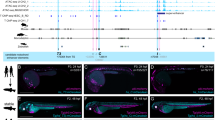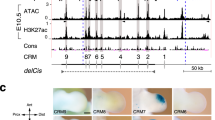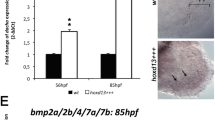Abstract
The T-box genes Tbx4 and Tbx5 have been shown to have key functions in the specification of the identity of the vertebrate forelimb (Tbx5) and hindlimb (Tbx4)1,2. Here we show that in zebrafish, Tbx5 has an additional early function that precedes the formation of the limb bud itself. Functional knockdown of zebrafish tbx5 through the use of an antisense oligonucleotide resulted in a failure to initiate fin bud formation, leading to the complete loss of pectoral fins. The function of the tbx5 gene in the development of zebrafish forelimbs seems to involve the directed migration of individual lateral-plate mesodermal cells into the future limb-bud-producing region. The primary defect seen in the tbx5-knockdown phenotype is similar to the primary defects described in known T-box-gene mutants such as the spadetail mutant of zebrafish3,4 and the Brachyury mutant of the mouse5, which both similarly exhibit an altered migration of mesodermal cells. A common function for many of the T-box genes might therefore be in mediating the proper migration and/or changes in adhesive properties of early embryonic cells.
This is a preview of subscription content, access via your institution
Access options
Subscribe to this journal
Receive 51 print issues and online access
$199.00 per year
only $3.90 per issue
Buy this article
- Purchase on Springer Link
- Instant access to full article PDF
Prices may be subject to local taxes which are calculated during checkout





Similar content being viewed by others
References
Takeuchi, J. K. et al. Tbx5 and Tbx4 genes determine the wing/leg identity of limb buds. Nature 398, 810–814 (1999)
Rodriguez-Esteban, C. et al. The T-box genes Tbx4 and Tbx5 regulate limb outgrowth and identity. Nature 398, 814–818 (1999)
Ho, R. K. & Kane, D. A. Cell-autonomous action of zebrafish spt-1 mutation in specific mesodermal precursors. Nature 348, 728–730 (1990)
Griffin, K. J. P., Amacher, S. L., Kimmel, C. B. & Kimelman, D. Molecular identification of spadetail: regulation of zebrafish trunk and tail mesoderm formation by T-box genes. Development 125, 3379–3388 (1998)
Wilson, V., Manson, L., Skarnes, W. C. & Beddington, R. S. The T gene is necessary for normal mesodermal morphogenetic cell movements during gastrulation. Development 121, 877–886 (1995)
Tickle, C. & Eichele, G. Vertebrate limb development. Annu. Rev. Cell Biol. 10, 121–152 (1994)
Cohn, M. J. & Bright, P. E. Molecular control of vertebrate limb development, evolution and congenital malformations. Cell Tiss. Res. 296, 3–17 (1999)
Gibson-Brown, J. J. et al. Evidence of a role for T-box genes in the evolution of limb morphogenesis and the specification of forelimb/hindlimb identity. Mech. Dev. 56, 93–101 (1996)
Ohuchi, H. et al. Correlation of wing-leg identity in ectopic FGF-induced chimeric limbs with the differential expression of chick Tbx5 and Tbx4. Development 125, 51–60 (1998)
Isaac, A. et al. Tbx genes and limb identity in chick embryo development. Development 125, 1867–1875 (1998)
Gibson-Brown, J. J., Agulnik, S. I., Silver, L. M., Niswander, L. & Papaioannou, V. E. Involvement of T-box genes Tbx2–Tbx5 in vertebrate limb specification and development. Development 125, 2499–2509 (1998)
Takabatake, Y., Takabatake, T. & Takeshima, K. Conserved and divergent expression of T-box genes Tbx2–Tbx5 in Xenopus. Mech. Dev. 91, 433–437 (2000)
Ruvinsky, I., Oates, A. C., Silver, L. M. & Ho, R. K. The evolution of paired appendages in vertebrates: T-box genes in zebrafish. Dev. Genes Evol. 210, 82–91 (2000)
Summerton, J. Morpholino anti-sense oligomers: the case for an RNaseH-independent structural type. Biochim. Biophys. Acta 1489, 141–158 (1999)
Nasevicius, A. & Ekker, S. C. Effective targeted gene ‘knockdown’ in zebrafish. Nature Genet. 26, 215–220 (2000)
Grandel, H. & Schulte-Merker, S. The development of the paired fins in the zebrafish (Danio rerio). Mech. Dev. 79, 99–120 (1998)
Neumann, C. J., Grandel, H., Gaffield, W., Schulte-Merker, S. & Nüsslein-Volhard, C. Transient establishment of anteroposterior polarity in the zebrafish pectoral fin bud in the absence of sonic hedgehog activity. Development 126, 4817–4826 (1999)
Grandel, H., Draper, B. W. & Schulte-Merker, S. dackel acts in the ectoderm of the zebrafish pectoral fin bud to maintain AER signalling. Development 127, 4169–4178 (2000)
Ros, M. A. et al. The limb field mesoderm determines initial limb bud anteroposterior asymmetry and budding independent of sonic hedgehog or apical ectodermal gene expressions. Development 122, 2319–2330 (1996)
Nelson, C. E. et al. Analysis of Hox gene expression in the chick limb bud. Development 122, 1449–1466 (1996)
Begemann, G. & Ingham, P. W. Developmental regulation of Tbx5 in zebrafish embryogenesis. Mech. Dev. 90, 299–304 (2000)
Russ, A. P. et al. Eomesodermin is required for mouse trophoblast development and mesoderm formation. Nature 404, 95–99 (2000)
Bruneau, B. G. et al. A murine model of Holt–Oram syndrome defines roles of the T-box transcription factor Tbx5 in cardiogenesis and disease. Cell 106, 709–721 (2001)
Li, Q. Y. et al. Holt–Oram syndrome is caused by mutation in TBX5, a member of the Brachyury (T) gene family. Nature Genet. 15, 21–29 (1997)
Basson, C. T. et al. Mutations in human TBX5 cause limb and cardiac malformation in Holt–Oram syndrome. Nature Genet. 15, 30–35 (1997)
Ahn, D., Ruvinsky, I., Oates, A. C., Silver, L. M. & Ho, R. K. tbx20, a new vertebrate T-box gene expressed in the cranial motor neurons and developing cardiovascular structures in zebrafish. Mech. Dev. 95, 253–258 (2000)
Acknowledgements
We thank A. Oates for helpful suggestions for the construction of the test construct for morpholino oligonucleotides, A. Bruce, A. Oates and I. Skromne for critical comments on the manuscript, I. Ruvinsky for helpful discussions, and H. Dow for fish care. This work was supported by a postdoctoral fellowship from the American Heart Association, Heritage Affiliate (to D.A.), a Cancer Training Grant from NIH (to M.J.K.), and grants from NIH (to L.M.S. and R.K.H.) and NSF (to R.K.H.).
Author information
Authors and Affiliations
Corresponding author
Ethics declarations
Competing interests
The authors declare that they have no competing financial interests
Supplementary information
Rights and permissions
About this article
Cite this article
Ahn, Dg., Kourakis, M., Rohde, L. et al. T-box gene tbx5 is essential for formation of the pectoral limb bud. Nature 417, 754–758 (2002). https://doi.org/10.1038/nature00814
Received:
Accepted:
Issue Date:
DOI: https://doi.org/10.1038/nature00814
This article is cited by
-
Optimal tagging strategies for illuminating expression profiles of genes with different abundance in zebrafish
Communications Biology (2023)
-
Galeaspid anatomy and the origin of vertebrate paired appendages
Nature (2022)
-
Hand2 delineates mesothelium progenitors and is reactivated in mesothelioma
Nature Communications (2022)
-
Deletion of morpholino binding sites (DeMOBS) to assess specificity of morphant phenotypes
Scientific Reports (2020)
-
Adipose fin development and its relation to the evolutionary origins of median fins
Scientific Reports (2019)
Comments
By submitting a comment you agree to abide by our Terms and Community Guidelines. If you find something abusive or that does not comply with our terms or guidelines please flag it as inappropriate.



